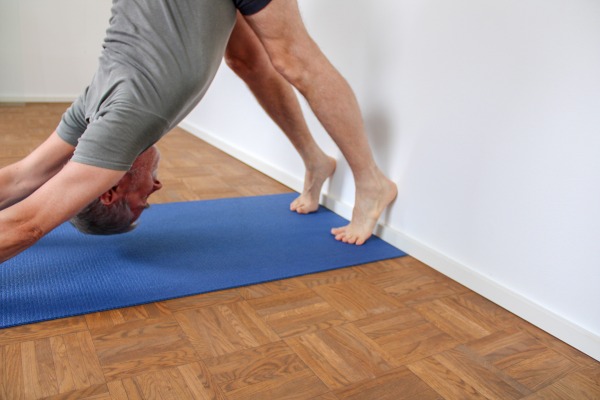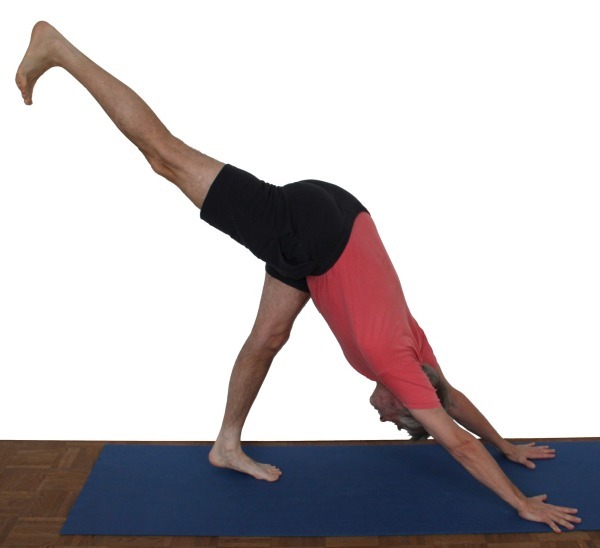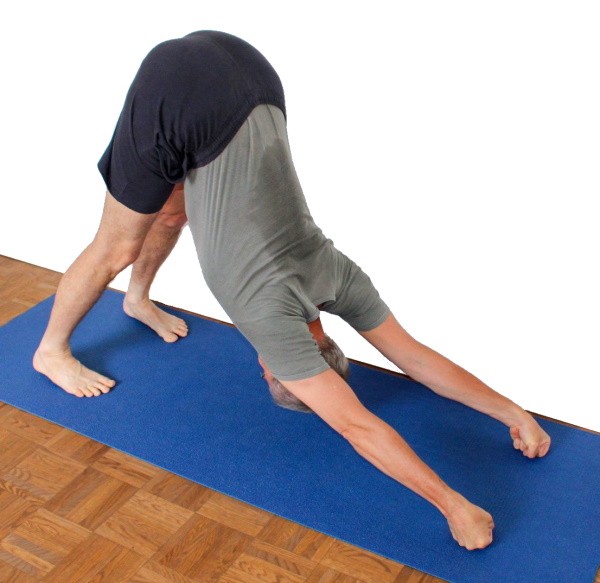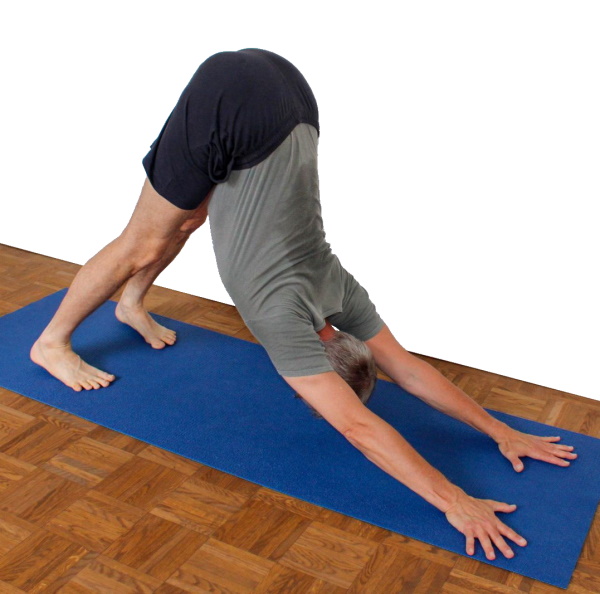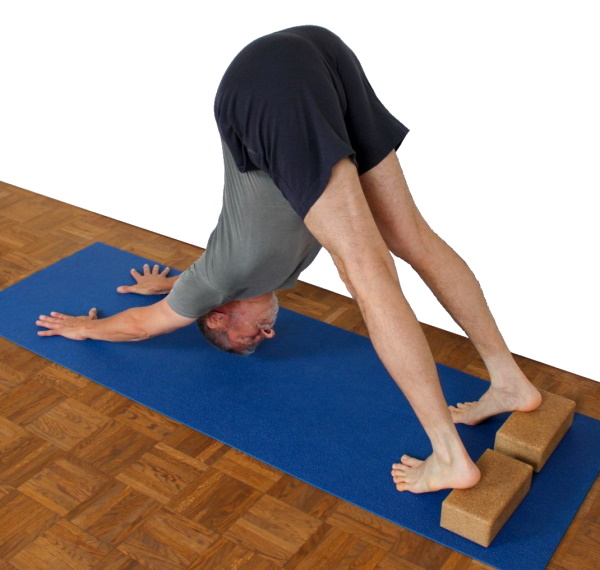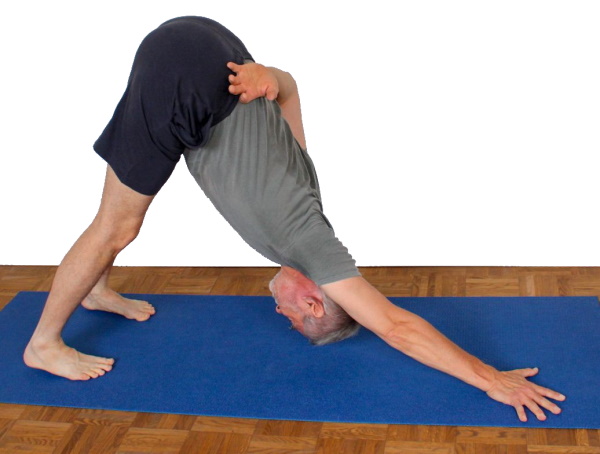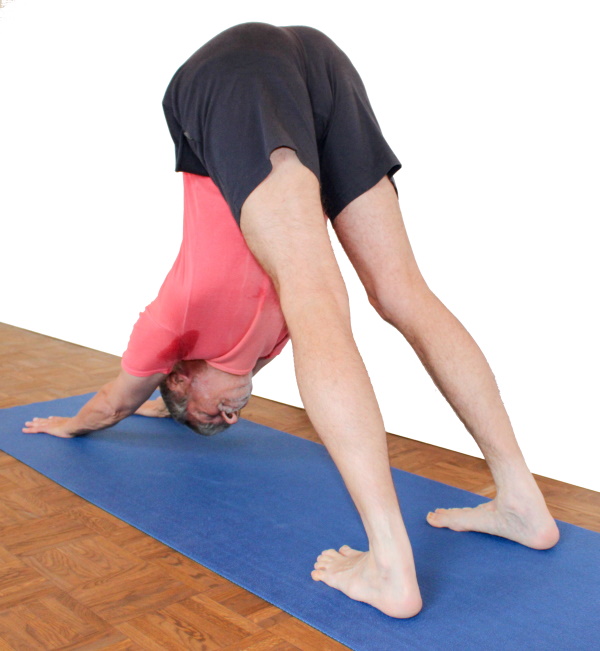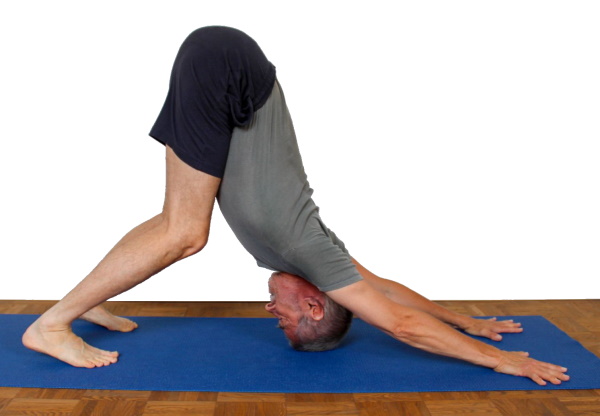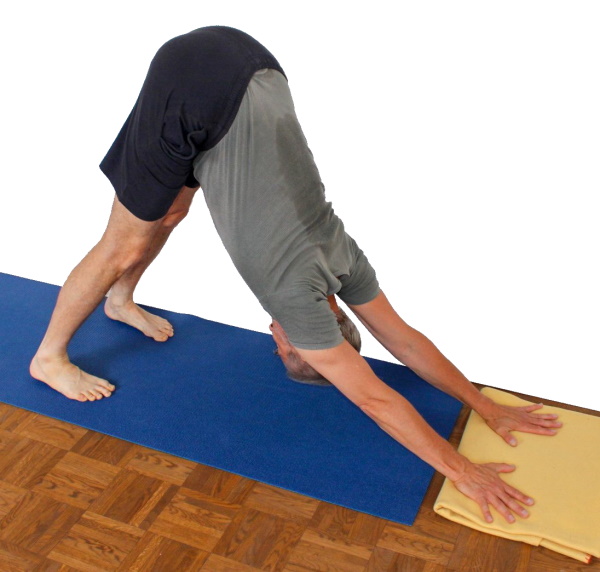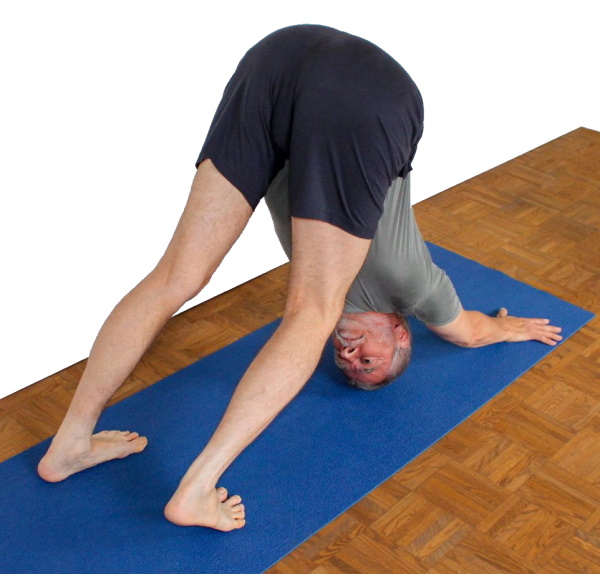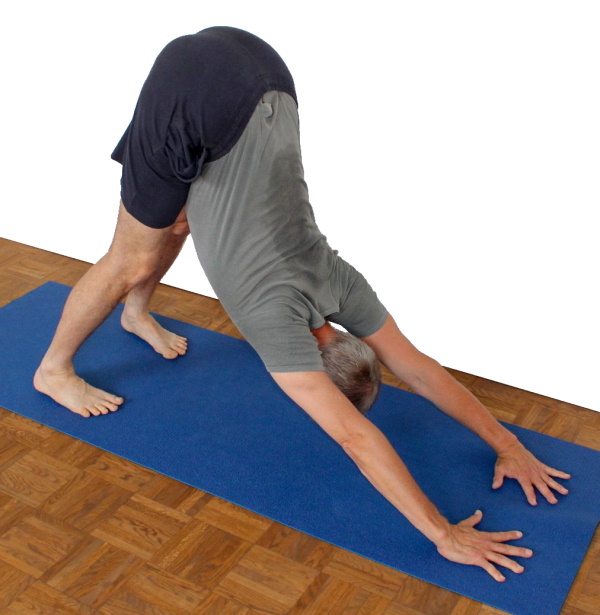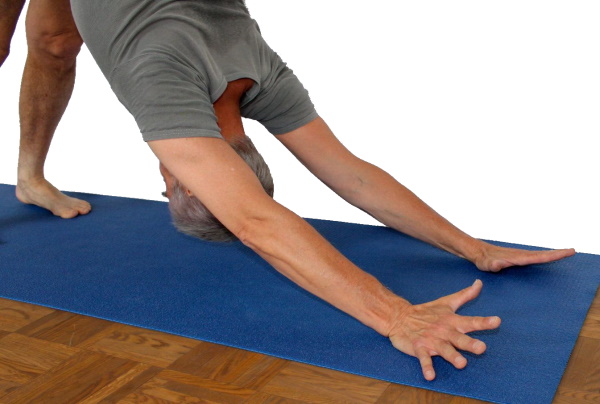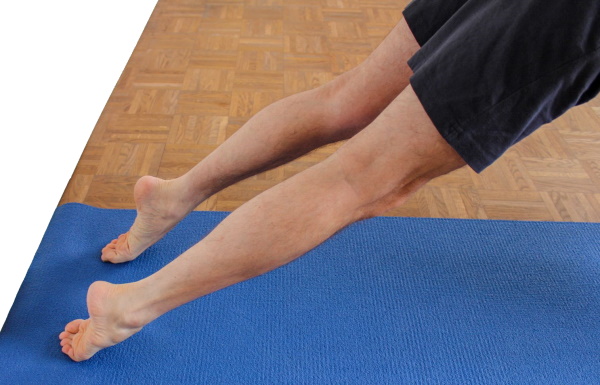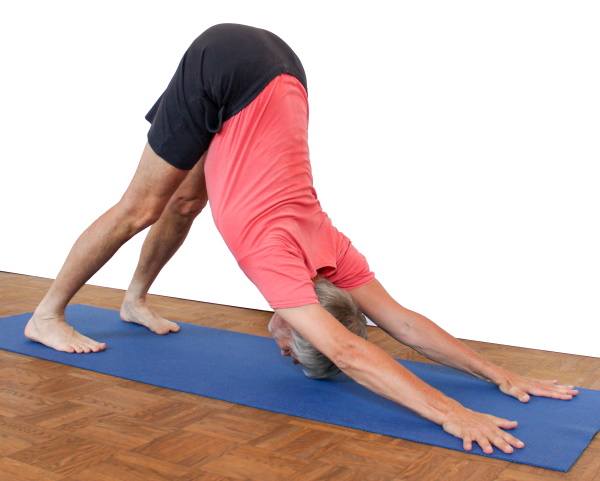- sitting upright on the lower legs
- bend the upper body forward and put it down on the thighs
- stretch your arms forward and place the palms shoulderwide on the ground.
- raise the pelvis until thighs are horizontal
- turn the toes over so that the underside of the toes are on the ground
- put weight on the hands
- stretch your legs backwards
- drop your heels
- tilt the pelvis forwards until (if possible) the sacrum is at least in the line between
pelvis and hands or even further.
- let the shoulder sink in the connecting line between wrists and ischial bone,
but don't move it forwards and downwards towards the hands,
but upwards and backwards towards the pelvis.
- press the respective inner
Finger base joints (articulation between finger and palm) firmly on the ground to distribute the pressure between the different parts of the hand and the fingers as evenly as possible
- exorotate the upper arms (i.e. the
tripezs to the ground)
- reach out from the shoulder as far back as possible
|
- pay attention to the legwork: thoroughly stretch the knees except the
rectus femoris part of the quadriceps would start to cramp (because it is
short in both joints, which it spans, and thus close to active insufficiency and cramping tendency), if so you should:
- not tilt the pelvis so far in dowaface dog
- practice stretchings of the
quadriceps more frequently
- bend your knees and tilt the pelvis further down instead of first stretching your legs and then bending the pelvis as usual
The flexion in the hips should be performed as isolated as possible from the parts of the m. iliopsoas and not at all from also hip bending
rectus femoris
- push the ischial bones away from the hands by power of the arms and shoulders,
means nothing more than to stretch as much as possible in all joints in between elevating the shoulder blades as well.
- keep abdominal muscles soft. The upper part of the body shouldn't be bent by the power of the
rectus abdominis, but rather be stretched as straight as possible based on a far tilted pelvis.
- on cramping tendency in the (deltoids) you can:
- if it significantly restricts the pose, more often practice
downface dog with the hands on the wall . Furthermore
- in between, or if the tendency to cramp hampers the pose too much, practice
gomukhasana. If the handstand can be practiced with bending arms, this is also highly recommended.
- inbetween practice
upface dog more often
- tonus-regulating exertion and strengthening of various kinds
- endorotate the thighs rather than turn them out and push them away from each other,
that pulls the ischial bones a little bit apart and promotes the ability to bend in the pelvis a little bit.
- in some cases, the weight distribution between the inner and outer foot requires special attention.
Especially in cases of shortened calf muscles it can be useful to focus more often on pressing
down the inner heel. For example, in the case of athletes who are regularly out heavy
strain on the lower leg muscles, such as by jogging, endurance running or the like,
because the gastrocnemius trained with it also supinates.
- Make sure that when the arms are turned out, the inner hands do not become light. instead constantly
work with the lower arm muscles,
palmar flexors and pronators of the wrists, because pressing down the inner
metacarpal joints (metacarpophalangeal joints) that have a tendency to take off is a combination of palmar flexion and
pronation of the forearm. Until further notive exorotate the upper arms to the maximum
- Difficulties with the wrists (usually dorsal) can occur after holding the position
for a long time and are almost always temporary. Helping against:
- in the position: the stronger pushing down of the
finger ground joints (metacarpal joints)
- after the pose: dorsal forearm stretching
- Make sure not to loose the exorotation of the arms when you stretch out from the shoulders.
The known connection between the three dimensions of motion (exorotation, (not) lateral-abduction,
maximum frontal-abduction) naturally applies and all the more so here.
The force acting in the direction of frontal abduction is great enough to force the shoulders
into the other two dimensions of movement in case of doubt, depending on which movement is
lighter or the other way around, which can be better controlled out of consciousness about it
and power to do it. Be careful not to allow the arms to move outwards and let them not
be turned into the endorotation.
- work with your hands in such a way that not one or more fingers turn to the side, which can be seen
e. g. by a nail tilted to the side. If this is the case, a sideways pushing movement of the whole
hand or individual fingers can be used to bring the fingers into the upright position
(against the friction resistance of the fingers on the surface). Probably this effect does not
affect all fingers equally. The indicated correction is therefore only intended as a
corrective measure for the unwanted fingers and accepts that the inclination of other fingers
may be overcompensated or that some fingers may even be rolled in the opposite direction.
The degree of correction is based on the most rotating finger. Of course, this instruction also
applies to the thumb, which for anatomical reasons cannot be expected to lie upright.
- Cramping tendency in the
m. trapezius should not occur; if so, you should first check whether it can be turned off with your own more powerful exorotation of the arms. If not, an assistant can turn out the arms correspondingly strong.
- spread the toes, as in different standing poses, in order to ensure that the
metatarsophalangeal joints of the toes are placed as evenly as possible on the floor.
- Sinking or pushing the heels down counteracts flexion in the hips in most cases,
as both movements are coupled via the limited flexibility of the back of the leg.
The gastrocnemius plays an important role here, bending the knee at the same time
as the plantar flexing the ankle. In downface dog, the opposite is performed
pronouncedly in both joints, so that it is strongly stretched here and usually
sets the limit in at least one of the two movements (flexion in the hips and plantar flexion).
Except for other (therapeutic) indications, the movement of the pelvis is the more
important: it is more important to tilt the pelvis as far as possible than to
force the heels to the floor; as a temporary focus, however, this makes sense.
- from the above instructions for taking the pose a clear measure results of the
distance of the hands to the feet. If you change from the downface dog to the upface dog,
the distance of the hands must be adjusted accordingly so that the wrists do not
stand further forward - better one or two centimetres back - than the shoulders.
If you change between these two poses several times, you should keep the of
upface dog and not change it every time you change the pose.
For downface dog this has the consequence that the pelvis tilts less or at least
less easy forwards (in the sense of flexion in the hips), which is the smaller
disadvantage compared to a too big distance in upface dog, which can cause an
evil hanging in the lower back and related missensations.
The advantages of the smaller distance for upface dog are described there,
among other things the transitions become more intensive and the Deltoideus can work better.
- in some people, the tendons of one or more fingers are shortened, usually the small finger.
This peculiarity impairs the execution of the pose only to the extent that, mostly,
the first finger joint cannot be pushed onto the ground. If an assistant is available,
the affected joint can usually be treated by the assistant. push it down slowly for
several minutes, which should be (almost) painless. Otherwise, a weight can be placed
on this joint. Fast successes are not to be expected, especially if it is a tendon contracture,
but a slow, steady improvement.
- when
palmar flexion is performed thouroughly, the work of the associated muscles of the forearm should
be clearly perceptible. In rare cases, this kind of muscular work can cause
irritation at the origin of the muscles in the forearm near the elbow joint
or show up a preexisting golfer elbow.
Then it is recommended to force this work in the dog's position less and
to practise the stretching of this muscle group with palms placed on the ground (palmar forearm stretching) more often.
Therapeutic weight training with many repetitions and such a light weight that
no pain occurs during the execution is usually helpful.
- especially when there is a lack of strength in the forearm muscles,
the carpus (carpal bones distal to the wrist) is often subjected to
a lot of unpleasant pressure. People with little training often have not only
little muscle to relieve this area actively, but also little protective muscle spanning the bones.
| known issues that may occur even when practicing correctly | - shoulder pain
For beginners who regularly or even ambitiously practice downface dog,
it can happen that they develop a slight cramp-like painfulness of the
front shoulder, which almost only occurs when the arms are held upside down.
This may also apply to the handstand and the rectangular handstand,
for example, and is a consequence of the disproportion of the requirement to
the current abilities of the muscles. It then makes sense to train
the (especially front) shoulders for strength and endurance in more moderate
angular ranges than in approx. 180° frontal abduction. Suitable are the
dip-variations of the poses with otherwise 180°-frontal abduction,
but above all the clean and intensive transition between
downface and upface dog. !
|
|




